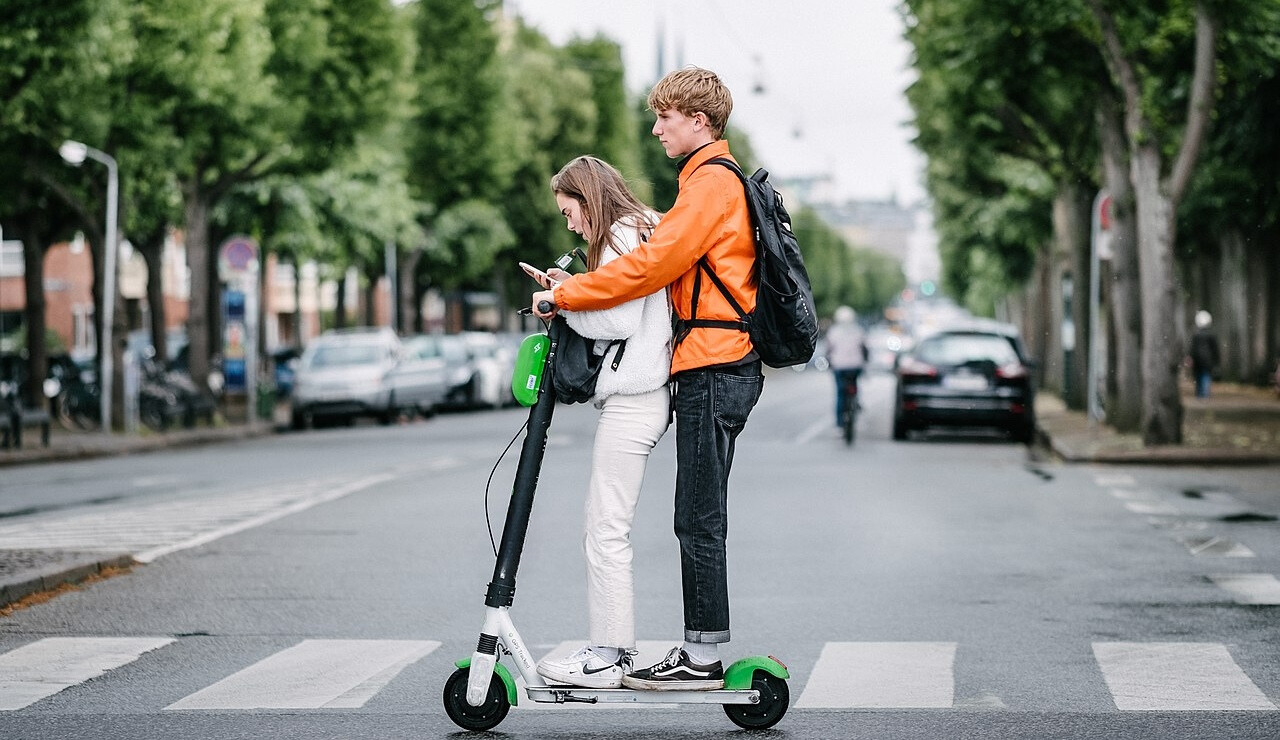Step to the side, traffic jams and honking horns—electric scooters are the smart way to move around the city. Most cities are now congested and while cycling may be an option for some, the reality is that if you’re going to work - you don’t want to get there sweaty and tired. Compact, sustainable, and seriously fun (take it from our riders who is the #1 thing they mention loving about owning a scooter); scooters—are rewriting the rules of urban travel.
What Makes a City 'Smart' Today?
While there is no single, universally accepted definition of a Smart City, there is general consensus that a Smart City is one that leverages data and technology to improve the quality of life for its citizens.
According to the U.S. Department of Transportation, there are three key hallmarks of smart cities and communities:
-
Networks of sensors that collect data
-
Connectivity that enables governments to interact with the community and manage infrastructure
-
Open data that fosters transparency and innovation
What’s particularly interesting, however, are the emerging [and “smart”] technologies that shape Smart Cities:
-
Information and communication technology (ICT): Tools and platforms used to store, manage, and share data intelligently and securely.
-
Internet of Things (IoT): A vast network of interconnected devices embedded with sensors and software that communicate and exchange data.
-
Automation: Streamlining everyday processes to make them faster, more efficient, and less reliant on manual intervention.
-
Artificial Intelligence (AI): Helping cities manage infrastructure efficiently, make informed decisions, and support sustainability goals.
-
Smart energy: AI-enabled smart grids give utility providers detailed insights into consumption patterns, allowing for more accurate forecasting, better outage management, and reduced carbon emissions.
-
Smart infrastructure: Innovations in managing utilities such as water and energy, and maintaining transportation systems, buildings, and public assets.
And last but not least:
-
Smart transportation: Using IoT, AI, and geolocation technologies, municipalities and partners collect real-time data to improve public transit systems—aiming to reduce traffic congestion and lower carbon emissions.
So, strictly speaking, scooters may not drive the future of Smart Cities. But they undoubtedly play a key role in shaping how cities evolve—offering a sustainable, flexible, and data-integrated mode of urban mobility.
The Rise of Electric Scooters in Urban Environments
Not that long ago—less than a decade, to be precise, around 2017—electric scooters were still a novelty. While scooters themselves had been around for years, it wasn’t until recently that adults began adopting them in a meaningful way. And let’s be honest—kicking your way around town wasn’t exactly sustainable. That’s when electric motors were added, and just like that, a new mode of transportation was born.
Fun fact: Did you know that electric scooters weren’t even available for purchase in Canada at the time? That gap in the market is exactly how Apollo Scooters came to be—one of the very first companies to introduce electric scooters to the Canadian market.
In the early days, scooters were primarily available as rentals, designed to solve the “last-mile” problem—bridging the distance between transit stops and final destinations like offices, campuses, or your favorite coffee shop. But they weren’t just a passing trend. They quickly became a fixture in cities, as sticky as a child’s hand on a summer popsicle. Once people discovered the benefits of using or owning a scooter—skipping traffic, avoiding parking fees, and cruising effortlessly through urban chaos—there was no turning back.
In fact, a study conducted in Atlanta found that when e-scooter services were removed, commuting times increased by 9–11%. That’s a clear sign: scooters aren’t toys. They’re a real, impactful solution in the modern urban transportation toolkit.
How E-Scooters Enhance Smart City Goals
So, why are scooters so crucial to the smart city movement? It’s actually quite simple: as mentioned earlier, the core idea behind Smart Cities is to improve quality of life. One of the biggest challenges urban dwellers face today is time lost in traffic—along with the more obvious consequences like air pollution and carbon emissions.
Electric scooters contribute to solving these problems in three key ways:
1. Reducing Traffic Congestion
Multiple studies have shown that the introduction of electric scooters has led to a reduction in traffic congestion, with decreases ranging from 5% to 11% in some cities. By offering an alternative for short-distance travel, scooters help reduce the number of cars on the road—especially for those quick errands or short commutes that would otherwise require a vehicle.
2. Promoting Eco-Friendly Transportation
This one’s a bit more nuanced. On the surface, electric scooters are clear winners—they produce zero tailpipe emissions and are highly energy-efficient (one kWh can power a scooter for over 80 miles). However, some studies (including research published on PubMed) point out that not all scooter rides are replacing car trips—some are replacing walking or cycling. While scooters are still a greener choice than cars, replacing active transport with motorized travel could have health and urban mobility implications.
Food for thought: the next time you hop on your scooter, try to use it in place of a car trip—not your 10,000 daily steps!
3. Boosting Equity & Affordability
Electric scooters expand access to transportation in areas that are underserved by buses or metro systems. They offer a low-cost, flexible alternative to car ownership, opening up mobility options for more people—especially in neighborhoods where public transit coverage is limited.
Scooters as Mobile Data Sources for City Planning
Here’s where it gets truly futuristic: a ride generates mountains of data—routes, speed, usage times. Cities can use scooter data analytics to redesign roads, adjust public transit, or optimize new bike lanes.
For example, Paris uses usage data to inform policy decisions; mobile tracking data helps reduce congestion and prioritize high-demand zones. In Santiago, Chile, e-scooters reduced metro usage in central zones by 21% while boosting ridership in less accessible regions—which signals multimodal planning potential. But - there’s one thing that keeps popping up in most research studies, articles, and in the news. Can electric scooters keep on growing without regulations and infrastructure? Are they a threat to cities? Let’s take a deeper dive into it:
Designing the City with Scooters in Mind
Most cities have already been built—unlike in the 1960s or 1970s, when urban planning still had the space and flexibility to design with future needs in mind. Today, we’re retrofitting existing cities to accommodate new modes of transportation, and it’s no easy task. As micromobility becomes more widespread, it brings a host of new challenges. An in-depth study by the University of Manitoba on electric scooter use in Canada concluded that we still have a long way to go before finding the ideal balance—but efforts are already underway around the world to seek out smart, adaptive solutions.
Key Aspects of Scooter Infrastructure
Pilot programs: From Australia and Europe to right here in Canada, many cities are running 2–3 year pilot programs to assess the impact of electric scooters. These programs help determine how scooters fit into city infrastructure and what kinds of regulations are needed to make them safe and effective for all. During these trials, scooter usage is typically restricted to specific zones and time periods. Once complete, the data collected will inform long-term decisions about legalization and regulation.
Check out our blog post about electric scooter laws in Australia
Zoning and curb management: One major issue identified in pilot programs is the clutter scooters create when not in use. Unlike cars or bikes, scooters often lack designated parking areas—especially outside of highly organized countries like the Netherlands. As a result, they’re frequently left blocking sidewalks and public spaces, creating hazards for pedestrians. To address this, most pilot programs now require scooters to be parked in designated zones or docking stations.
Dedicated lanes: While not exclusive to scooters, their rise has accelerated demand for micromobility lanes. These lanes allow scooters to stay off sidewalks and out of car lanes—both of which can be dangerous or disruptive. In the future, we might even see further specialization: perhaps separate lanes for motorized versus non-motorized micromobility. (Just a theory for now—there’s currently no literature indicating cities are actively planning this.)
As cities continue to evolve, these efforts signal a growing willingness to adapt and experiment—all in pursuit of smarter, more inclusive urban mobility.
Electric Scooter Regulations
While regulations vary from city to city—and sometimes even between neighborhoods within the same city—governments around the world are beginning to align on several key standards when it comes to electric scooters:
-
Maximum speed of 25 km/h (15 mph) – aligned with most bicycle regulations.
-
Minimum riding age of 18 years old – to ensure a basic level of responsibility and awareness.
-
Helmet use is mandatory – for rider safety.
-
No use of electronic devices while riding – such as headphones or mobile phones, to minimize distractions.
-
No drinking and driving – scooters are considered vehicles and follow similar rules to cars in this regard.
-
Scooters must ride in bike lanes or on the street – sidewalks are off-limits due to the risk they pose to pedestrians.
So far, licenses have not been required to operate an electric scooter—but that could change. We foresee a time when licenses may be mandated for any scooter capable of exceeding the 25 km/h threshold, similar to mopeds or other low-speed motorized vehicles.
These regulations focus primarily on riders—but increasingly, governments are also holding manufacturers accountable. In many jurisdictions, UL (Underwriters Laboratories) certification is now a requirement to legally sell electric scooters. This ensures the product meets strict safety standards—particularly around construction and battery performance. Battery safety has become a growing concern due to reports of overheating and fires, making certification a key step in protecting riders and the public.
Challenges & Considerations for City Planners
It’s not all smooth riding. As with any emerging technology, electric scooters come with their own set of risks and challenges—especially when physical infrastructure hasn’t yet caught up. While these vary depending on the city, here are some of the most common issues:
Safety Hazards
Accidents involving electric scooters are becoming increasingly frequent. These range from reckless driving to improper parking that creates obstacles or hazards in public spaces. Cities are actively seeking solutions to reduce these risks. Addressing improper parking is relatively straightforward—more docking stations and designated parking zones can help—but reckless riding is more complex. Many accidents are linked to younger or inexperienced riders who struggle to assess the risks of traveling at high speeds. Even minor road imperfections, like small potholes, can pose serious threats. In Germany, for example, 22 fatalities and over 1,000 serious injuries were reported last year due to improper e-scooter use, according to Dekra.
Lack of Dedicated Lanes
In already congested urban environments, adding new infrastructure—like dedicated micromobility lanes—is a major challenge. But without them, scooter riders are often forced to share space with either pedestrians or cars, increasing risk for everyone. A study in the Netherlands (a country renowned for its micromobility infrastructure) found that 71% of scooter riders who used the sidewalk did so due to poor pavement conditions. If that’s the case in the Netherlands, it’s likely even more pronounced in cities with less developed infrastructure.
The Future Is Two-Wheeled
Of course, we’re biased—we believe electric scooters are the future. But as adoption continues to grow worldwide, it’s becoming increasingly clear that they’re more than just trendy gadgets—they’re transforming the way cities move. We're seeing an exciting shift: more models, more brands, more price ranges, and importantly, more regulations being developed specifically for scooters.
What’s next? Hopefully, dedicated lanes for low-speed motorized vehicles—like electric scooters, e-bikes, and mopeds. Let’s be real: scooters don’t quite fit in with bikes, skaters, or pedestrians. They’re in a category of their own. They don’t belong on sidewalks, but riding on busy streets isn’t always safe either. It’s like they’re still carving out their place in the urban landscape—finding where they truly belong.
So next time you zip through the city on a scooter, remember: you’re not just commuting—you’re riding into the future.






